What are the best plants for rock gardens?
As the name suggests, Rock Gardens are a hardscape surface that involves both the presence of rocks and the great number of plants they can inhabit.
It is built with the aim that the beauty of the stones will be appreciated as much as the vibrance of the flowering plants and that both the components, rocks, and garden, will merge seamlessly to create a magnificent ambiance.
When it comes to rock gardens, there is a frequent misconception. People often believe that rock gardens are a type of plant classification.
However, that is not true as these plants only share some similar characteristics and are not listed in any classification as ‘rock garden plants.
They can be grown anywhere else in the absence of rocks, stones, or gravel.
Finding a suitable spot to establish your rock garden is perhaps the most tricky and challenging phase.
You will need to remain patient because you will have to let go of many spots that you find attractive at first glance.
This is because a rock garden should be developed in a place with abundant sunlight.
You have to make sure that it is not partial sunlight and that the plants can have as much afternoon light in the day as possible.
Another thing that you need to ensure while making a rock garden is a proper drainage system for your plants.
Because your plants will be concentrated in a compact space and surrounded by rocks, the plants might likely suffer due to improper drainage.
Roots could rot, and leaves are very likely to be swollen in the absence of an effective drainage system.
Here are 50 such plants you can grow in your rock garden and give your space a vibrant and attractive look.
50 Best Plants for Rock Gardens
- Yellow Alyssum (Aurinia saxatilis)
- Ice Plant (Delosperma Cooperi)
- Angelina Stonecrop (Sedum rupestre ‘Angelina’)
- Dragon’s Blood Stonecrop (Sedum spurium)
- Hens and Chicks (Sempervivum tectorum)
- Creeping Thyme (Thymus serpyllum)
- Blue Fescue Grass (Festuca glauca)
- Snow-in-Summer (Cerastium tomentosum)
- Candytuft (Iberis sempervirens)
- Ajuga (Ajuga reptans)
- Creeping Phlox (Phlox subulata)
- Pasque Flower (Pulsatilla vulgaris)
- Reticulated Iris (Iris reticulata)
- Wood Spurge (Euphorbia amygdaloides)
- Moonbeam Coreopsis (Coreopsis verticillata ‘Moonbeam’)
- Lavender (Lavandula spp.)
- Yarrow (Achillea millefolium)
- Autumn Joy Sedum (Hylotelephium herbstfreude)
- Spiked Speedwell (Veronica spicata ‘Royal Candles’)
- Columbine (Aquilegia spp.)
- Coneflower (Echinacea spp.)
- Purple Fountain Grass (Pennisetum setaceum ‘Rubrum’)
- Blue Rug Juniper (Juniperus horizontalis ‘Wiltonii’)
- Shasta Daisy (Leucanthemum x superbum)
- Black-Eyed Susan (Rudbeckia hirta)
- Perennial Salvia (Salvia spp.)
- Six Hills Giant Catmint (Nepeta ‘Six Hills Giant’)
- Russian Sage (Perovskia atriplicifolia)
- Mugo Pine (Pinus mugo)
- Rock spray Cotoneaster (Cotoneaster horizontalis)
- Lamb’s Ear (Stachys byzantina)
- Maiden Grass (Miscanthus Sinensis ‘Gracillimus’)
- Rugosa Rose (Rosa rugosa)
- Rock Cress (Arabis)
- Donkey Trails
- Spiderwort
- Thrift (Armeria Maritima)
- Tickseed (Coreopsis)
- Irish Moss (Sagina Sabulata)
- Nasturtium
- Prickly Pear Cactus (Opuntia)
- Geranium Shepherds Warning (Geranium sanguineum)
- Ajuga Black Scallop (Ajuga Reptans Binblasca)
- Basket of Gold (Aurinia saxatilis)
- Crested iris (Iris Cristata)
- Snow Flurry Aster (Symphyotrichum ericoides)
- Hardy Plumbago (Ceratostigma plumbaginoides)
- Missouri Evening Primrose (Oenothera missouirensis)
- Blue Zinger Sedge (Carex Flacca)
- Cushion Spurge (Euphorbia Polychorma)
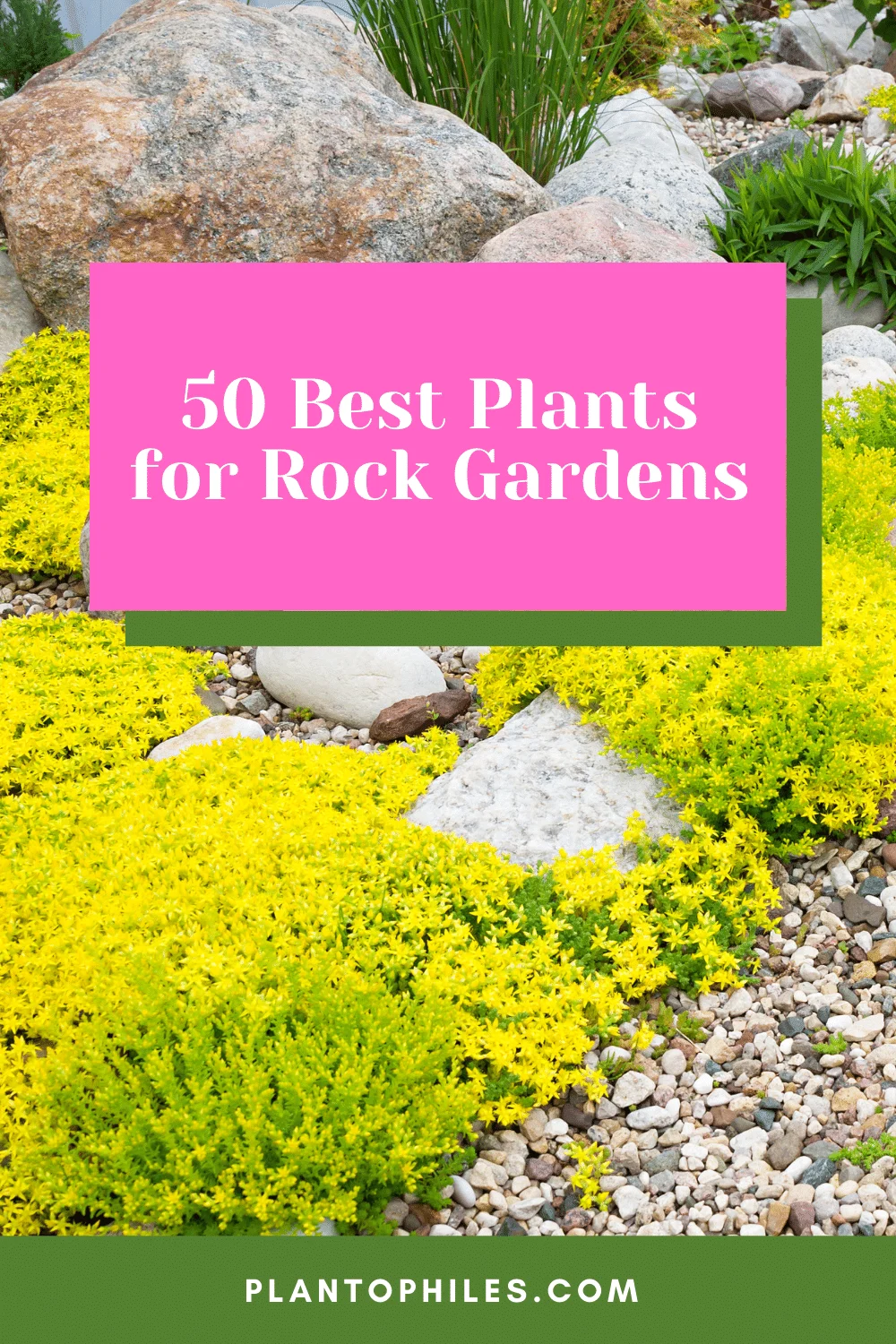
50 Best Plants for Rock Gardens
Table of Contents
50 Best Plants for Rock Gardens
1. Yellow Alyssum
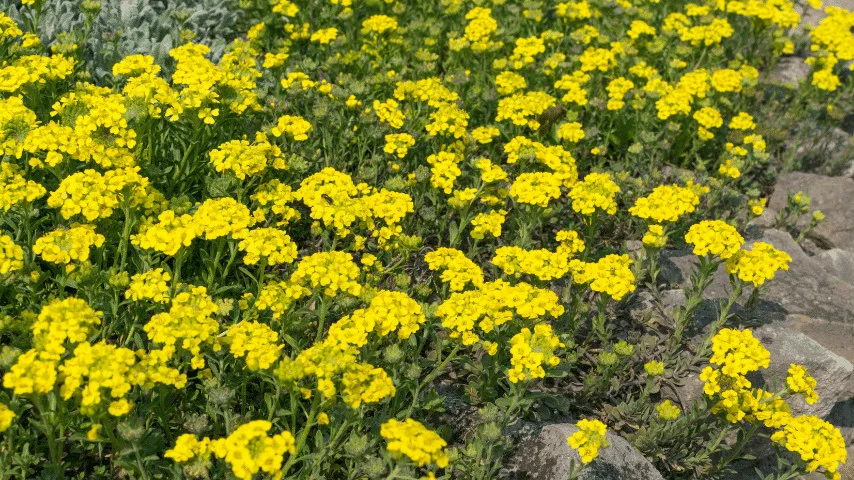
Yellow Alyssum (Aurinia Saxatilis) drought-tolerant plant, best for your Rock Garden
Yellow alyssum is a drought-tolerant plant that blooms with tiny yellow flowers in April and May.
According to Cornell University, this plant is also known as basket or cloth of gold.
- Temperature: USDA hardiness zones for this plant are 3 to 7
- Plant Color: Produces yellow flowers
- Sun Exposure: Requires full sun to thrive
- Soil Conditions: Needs well-drained, dry and sandy soil
- Plant Type: Yellow alyssum is a perennial plant.
- Average height: Grows up to 6 to 12 inches tall
2. Ice Plant
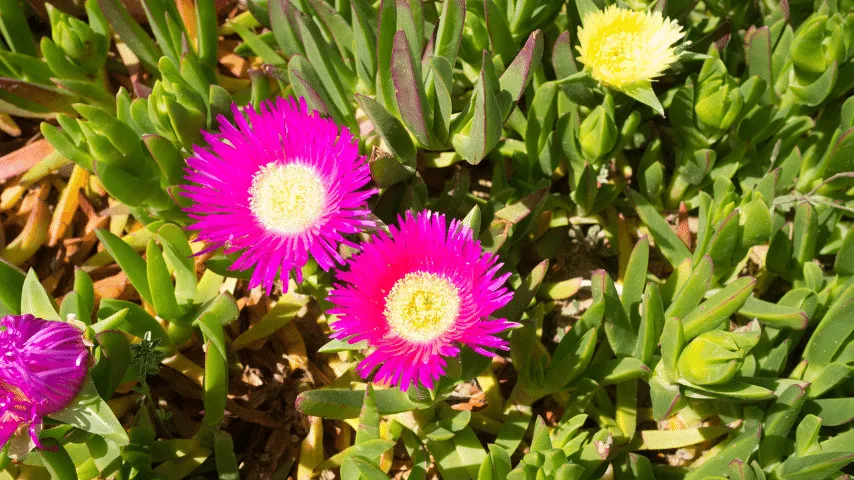
Ice Plant (Delosperma Cooperi) grows at its best potential, provided that it has a good drainage system in your rock garden
Ice Plant is more commonly used as a ground cover, this plant grows at its best potential, provided that it has a good drainage system.
- Temperature: USDA hardiness zones for this plant are 6 to 10
- Plant Color: Produces a variety of red and purple flowers
- Sun Exposure: Requires full to partial sunlight
- Soil Conditions: Will do with average to poor soil; well-drained and dry.
- Plant Type: Ice plant is a succulent
- Average height: Grows about 6 to 8 inches tall
3. Angelina Stonecrop
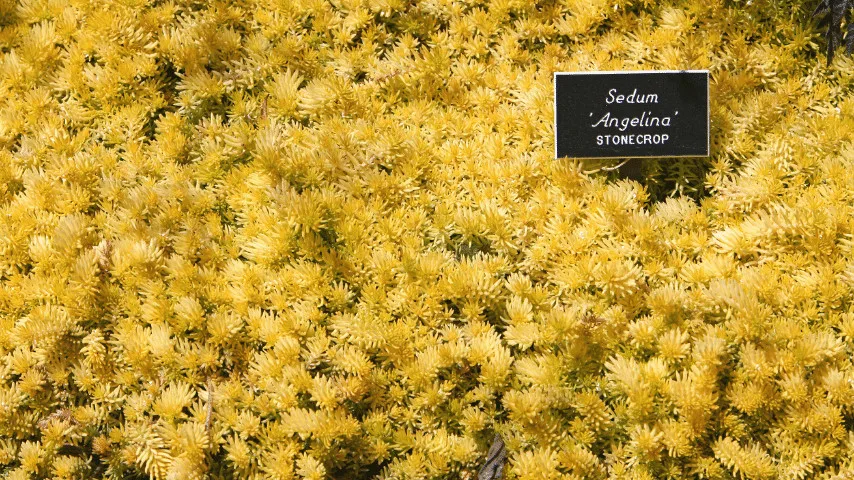
Angelina Stonecrop (Sedum rupestre ‘Angelina’) is, the best choice for your rock garden
Angelina Stonecrop is quite famous for its star-shaped flowers that bloom in the presence of bright sunlight.
Make sure that it gets sunlight for at least six hours a day to maximize the green foliage and production of golden flowers.
- Temperature: USDA hardiness zones for this plant are 5 to 8
- Plant Color: Produces yellow clustered leaves
- Sun Exposure: Requires full sunlight for about six to eight hours a day
- Soil Conditions: Well-drained, medium moisture soil.
- Plant Type: Angelina stonecrop is an evergreen perennial plant
- Average height: Grows 4 to 6 inches tall
4. Dragon’s Blood Stonecrop
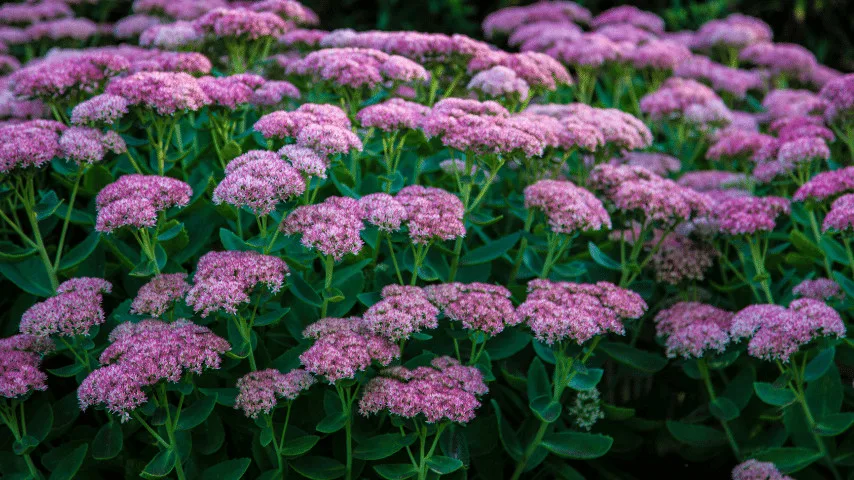
Dragon’s Blood Stonecrop (Sedum spurium) is resistant to drought, it will be good to grow in your rock garden
Even if you plant Dragon’s Blood Stonecrop in shallow or loose soil, it will be good to grow in your rock garden.
It is greatly resistant to drought and bears extremely small pink flowers with a reddish tint.
- Temperature: This plant is hardy in USDA zones 4 to 9
- Plant Color: Produces a pink variety of small bright flowers
- Sun Exposure: Requires full sun to thrive
- Soil Conditions: Soil should be well-drained. It should have medium moisture, and the pH should be acidic.
- Plant Type: It is a succulent, perennial plant
- Average height: 4 to 6 inches
5. Hens and Chicks
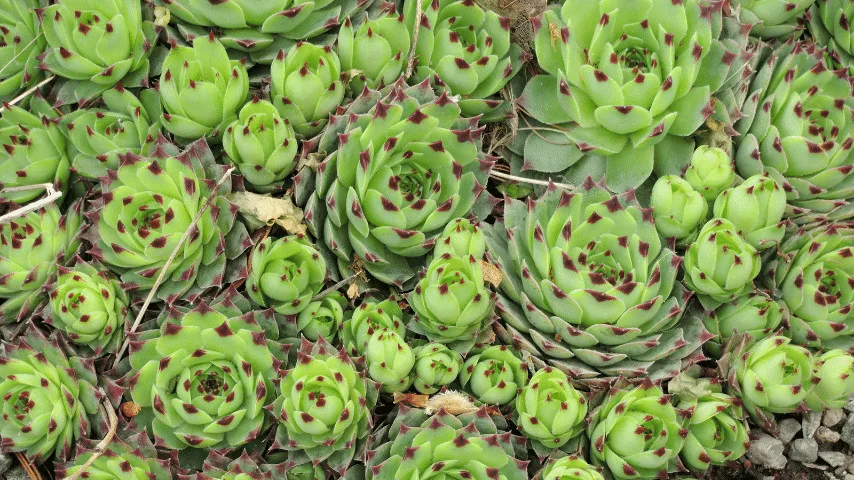
Hens and Chicks (Sempervivum tectorum) succulent plant, it will be good to grow in your rock garden
Succulent plants include hens and chicks. They are called hens and chicks because they bear large green rosettes,
which are called the hens. Smaller rosettes, called chicks, further accompany these hens.
- Temperature: This plant is hardy in USDA zones 3 to 8
- Plant Color: Produces red and purple rosette clusters.
- Sun Exposure: Requires full sun
- Soil Conditions: Average form of soil; must be well-drained
- Plant Type: grows up to 4 to 6 inches tall
- Average height: Hens and Chicks is a succulent plant
6. Creeping Thyme
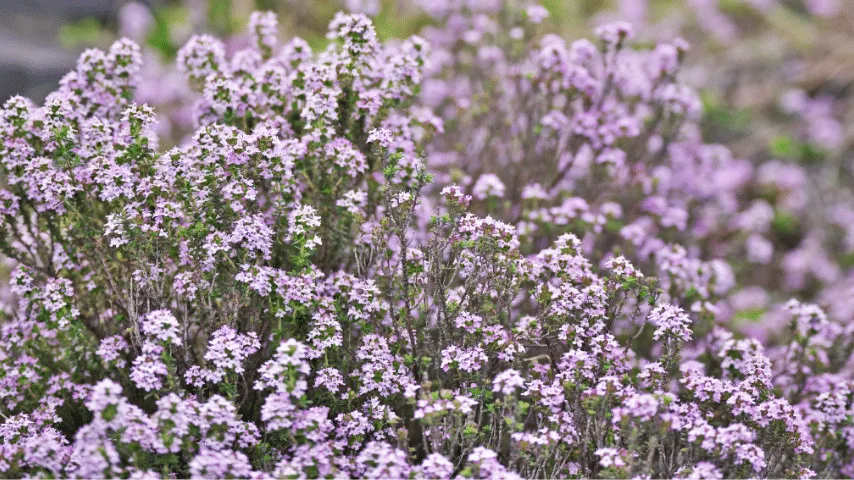
Creeping Thyme (Thymus serpyllum) grows well in the rock garden with proper drainage
Creeping thyme is known for its aromatic properties and grows well in soil with proper drainage.
- Temperature: This plant is hardy in USDA zones 4 to 8
- Plant Color: Produces pink, extremely tiny flowers
- Sun Exposure: Requires full exposure to the sun all-day
- Soil Conditions: The plant will do good in poor nutrient soil, provided that it has a proper drainage system.
- Plant Type: Creeping Thyme is a perennial woody shrub
- Average height: Grows very little, reaching only about two to three inches in height.
7. Blue Fescue Grass
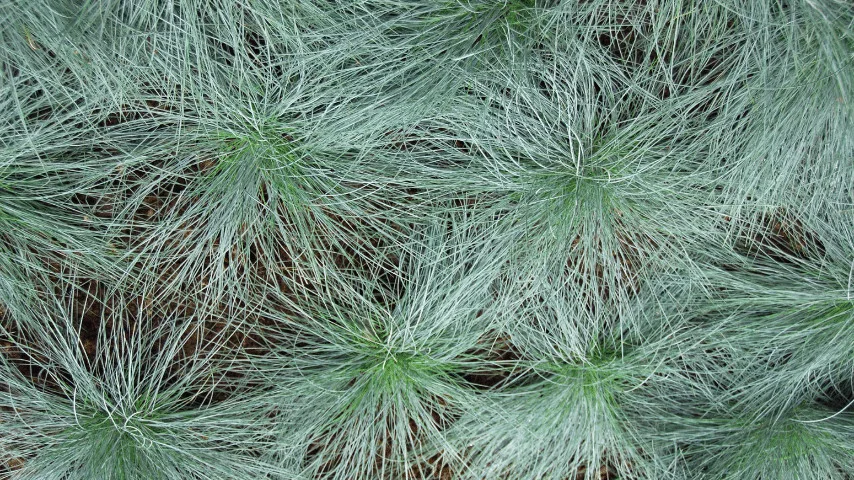
Blue Fescue Grass (Festuca glauca)
While blue fescue grass shows remarkable growth in full sunlight, it will also do well in part shade.
- Temperature: This plant is hardy in USDA zones 4 to 8
- Plant Color: Tinted blue leaves and produce yellow-green flowers.
- Sun Exposure: Requires full exposure to the sun; however, will also tolerate part shade.
- Soil Conditions: Well-drained soil should have dry to medium moisture.
- Plant Type: It is a perennial plant
- Average height: Grows about 6 to 28 inches in width and 1 to 3 feet in height.
8. Snow-in-Summer
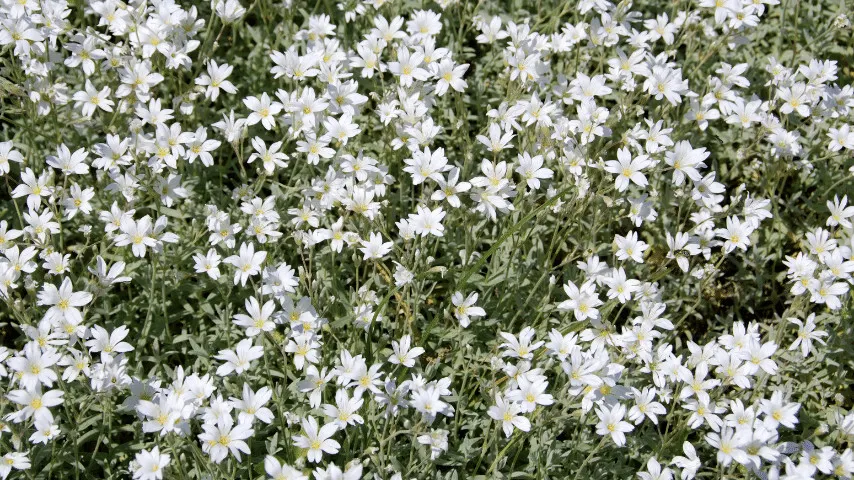
Snow-in-Summer (Cerastium tomentosum) produces white snow-like flowers that bloom in summer, perfect for your rock garden
This plant is so-called because it produces white snow-like flowers that bloom in summer.
- Temperature: This plant is hardy in USDA zones 3 to 7
- Plant Color: Produces pristine white flowers and bears small green flowers
- Sun Exposure: Requires full sun to thrive
- Soil Conditions: Soil should be sandy, dry, and well-drained.
- Plant Type: It is a perennial plant
- Average height: Grows about 6 to 12 inches in height and 10 to 18 inches in width.
9. Candytuft
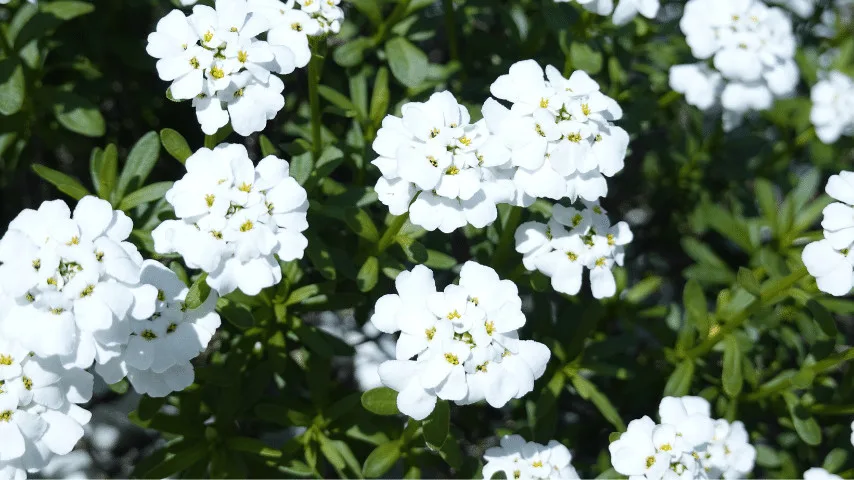
Candytuft (Iberis sempervirens) plant forms beautiful clusters of white flowers and grows in your rock garden
Despite having a not-so-pleasant aroma, this plant forms beautiful clusters of white flowers in April.
- Temperature: USDA hardiness zones for this plant are 3 to 8
- Plant Color: Bears white and pink flowers with small petals forming a beautiful pattern
- Sun Exposure: Requires full sun
- Soil Conditions: Soil should be partially moisture and well-draining.
- Plant Type: Candytuft is a perennial plant
- Average height: Grows to a height of 6 to 8 inches and spreads to a width of 12 to 34 inches.
10. Ajuga
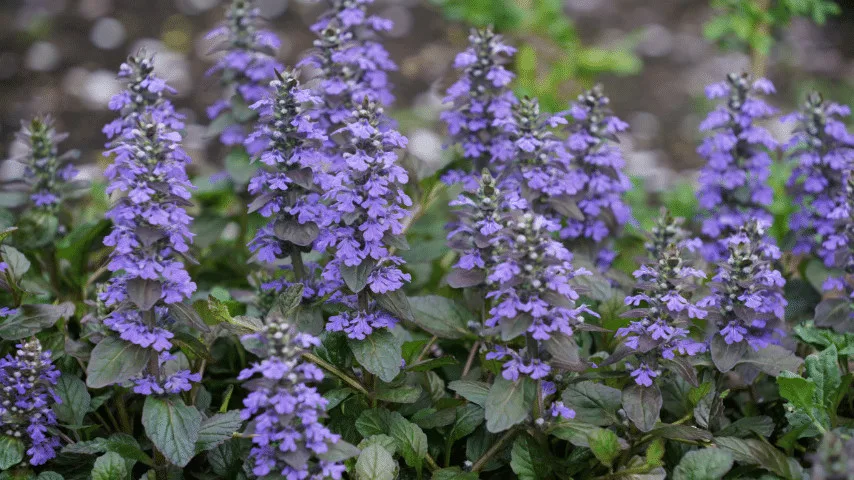
Ajuga (Ajuga reptans) is best for rock gardens if you keep them in a compact space
This plant is best for rock gardens if you keep it in a compact space. After a good amount of spreading on the land, it takes the shape of a mat.
- Temperature: USDA hardiness zones for this plant are 3 to 10
- Plant Color: produces blue and violet striking small flowers.
- Sun Exposure: Can survive in full as well as partial shade
- Soil Conditions: Soil should be well-drained and medium-moistured.
- Plant Type: Ajuga reptans is a perennial rock garden plant
- Average height: Grows up to 5 to 14 inches high
11. Creeping Phlox
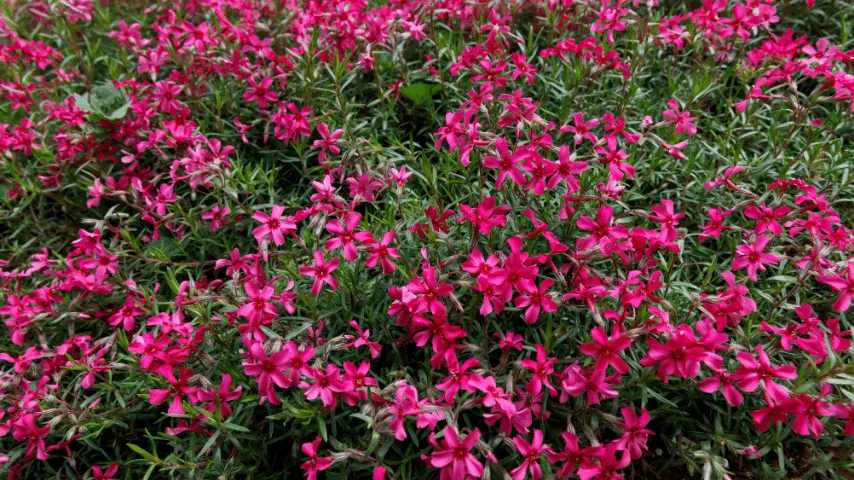
Creeping Phlox (Phlox subulata) can withstand drought and grows well in your rock garden
Creeping Phlox can withstand drought, poor soil, and extreme humidity levels.
- Temperature: USDA hardiness zones for this plant are 3 to 9
- Plant Color: Bears flowers in several colors, including white, pink, blue, purple, and white.
- Sun Exposure: Thrives in full sun
- Soil Conditions; Soil should be like hummus, well-drained, and medium-moistured.
- Plant Type: herbaceous perennial
- Average height: it grows 6 to 12 inches tall and 9 to 26 inches wide
12. Pasque Flower
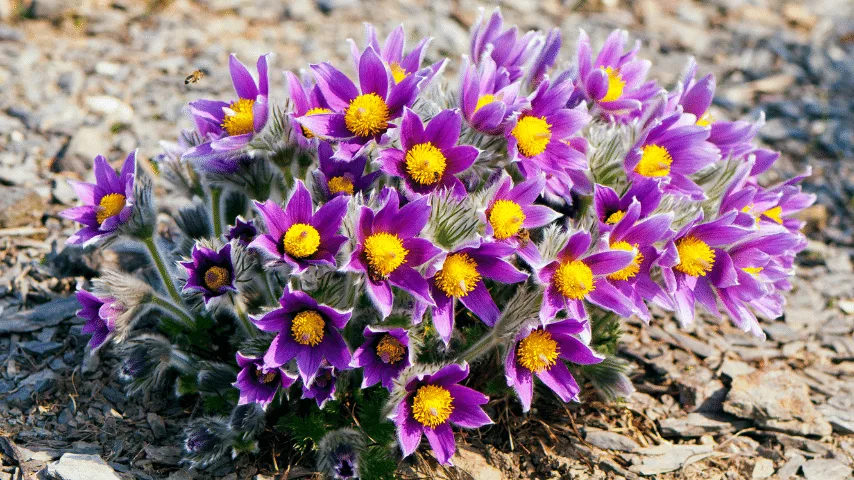
Pasque Flower (Pulsatilla vulgaris) bears light purple flowers and thrives well in your rock garden
Pasque starts blooming as soon as spring starts and bears light purple flowers.
- Temperature: This plant is hardy in USDA zones 4 to 8
- Plant Color: It produces purple and white rounded flowers
- Sun Exposure: Can tolerate full sun as well as partial sunlight.
- Soil Conditions: Should be humusy and well-drained, with a neutral pH.
- Plant Type: herbaceous perennial
- Average height: it grows 12 inches tall and also 12 inches wide
13. Reticulated Iris
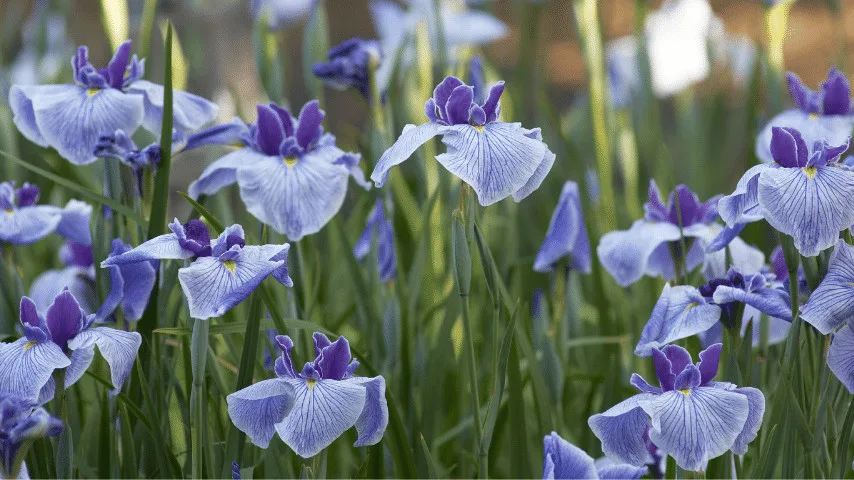
Reticulated Iris (Iris reticulata) plant them in abundance in your rock garden
Because these plants are extremely small, it is best if you plant them in abundance so that they increase the visibility span.
- Temperature: USDA hardiness zones for this plant are 5 to 9
- Plant Color: It produces blue or purple flowers with yellow tubular centers.
- Sun Exposure: Requires full exposure to the sun in most of the months.
- Soil Conditions: Can tolerate average nutrition and well-drained soil.
- Plant Type: it is a perennial bulb
- Average height: Reticulared Iris grows 4 to 6 inches tall.
14. Wood Spurge
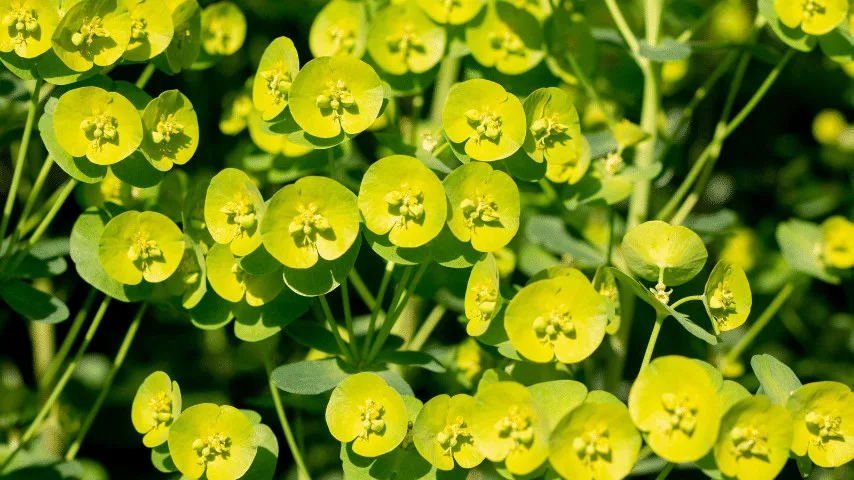
Wood Spurge (Euphorbia amygdaloides) can make a great addition to your rock garden, giving it a bright and magnificent look
With its purple-tinted flowers, Wood spurge can make a great addition to your rock garden, giving it a bright and magnificent look.
The best part about it is that it can tolerate poor-quality soil, so you do not have to worry about fertilizing it every once in a while.
It is also tolerant of shady places. However, it will need a proper drainage system to show appropriate signs of growth.
- Temperature: USDA hardiness zones for this plant are 6 to 8
- Plant Color: Produces yellow flowers with purple edges
- Sun Exposure: Can tolerate part shade
- Soil Conditions: Soil should be medium moisture and well-drained.
- Plant Type: Evergreen perennial
- Average height: It only grows about 1 to 2 inches in height
15. Moonbeam Coreopsis
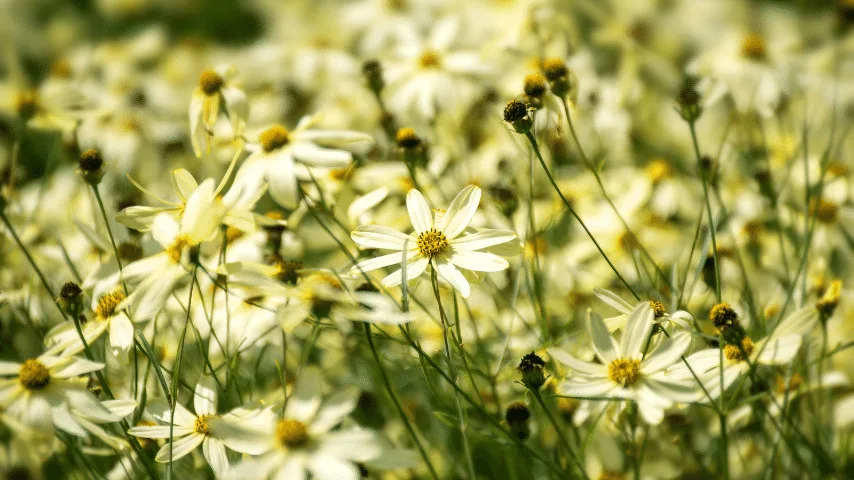
Moonbeam Coreopsis (Coreopsis verticillata ‘Moonbeam’) is perfect for your rock garden, as it shows excellent signs of growth
This is a perennial plant that belongs to the aster family.
It is perfect for your rock garden, as it shows excellent signs of growth in rocky soil and can also tolerate a small amount of humidity and drought.
- Temperature: USDA hardiness zones for this plant are 3 to 9
- Plant Color: produces yellow flowers, just like sunflowers.
- Sun Exposure: Requires full sun
- Soil Conditions: Soil should be well-drained and medium-moistured.
- Plant Type: it is a perennial plant
- Average height: Reaches an excellent height of about 18 to 20 inches tall
16. Lavender
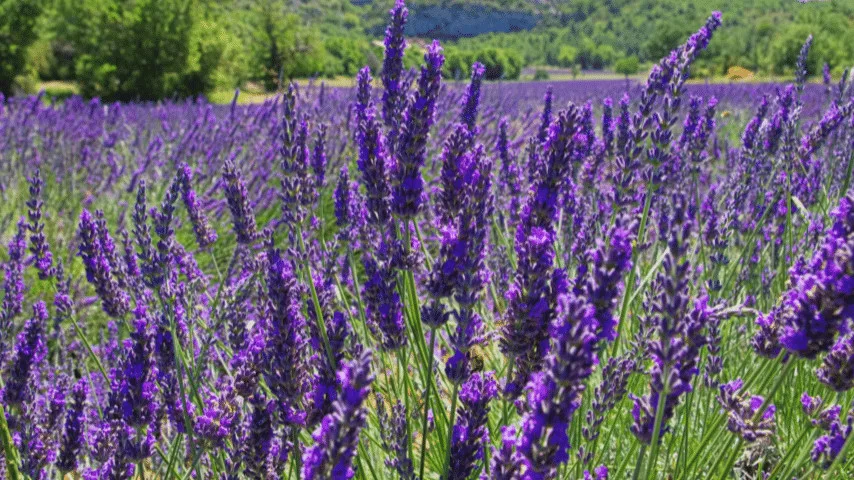
Lavender (Lavandula spp.) very popular in a rock garden, primarily for its aromatic properties
Lavender, in particular, is known to be very popular in a rock garden, primarily for its aromatic properties and its purple blooming flowers.
You can plant it in infertile soil, but make that the drainage system is in good working order.
- Temperature: USDA hardiness zones for this plant are 5 to 8
- Plant Color: Produces long purple flowers
- Sun Exposure: Requires full sun for optimum growth
- Soil Conditions: Soil should have a basic pH. It must be well-drained of excess water and should be humusy.
- Plant Type: Lavandula spp is a herb.
- Average height: ranges from as short as 12 inches and as long as 3 feet.
17. Yarrow
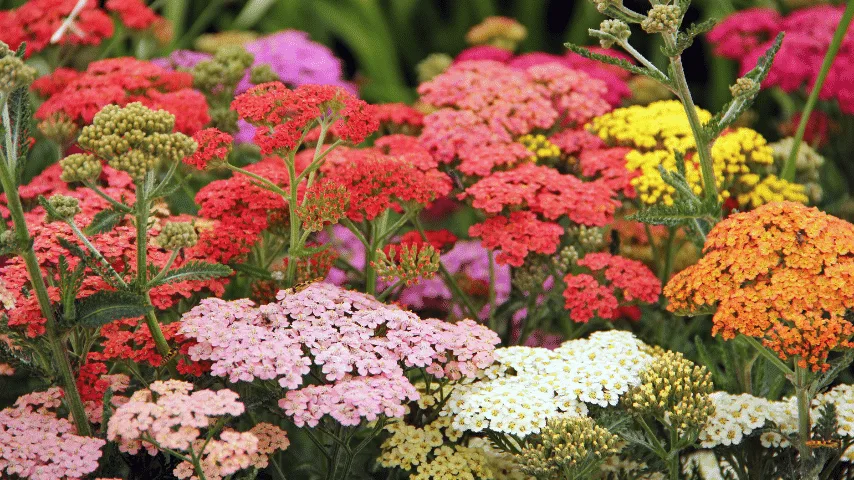
Yarrow (Achillea millefolium) rock gardens are a perfect habitat for such plants because they can spread very conveniently and rapidly
Even though yarrow is usually grown in average soil, it will still do well when planted in poor soil in a rock garden.
The rock gardens are a perfect habitat for such plants because they can spread very conveniently and rapidly otherwise, in an open space such as a pot.
Because a rock garden has many different plants in the same proximity, plants are very compact, and therefore, the chances of spreading are very controlled.
- Temperature: USDA hardiness zones for this plant are 3 to 9
- Plant Color: Bears flowers of different colors, namely white, pink, red, and yellow.
- Sun Exposure: Thrives in full daylight
- Soil Conditions: Soil should be lean and well-drained.
- Plant Type: Yarrow is a flowering plant
- Average height: Grows around 3 to 4 feet in width and 1 to 3 feet in height.
18. Autumn Joy Sedum
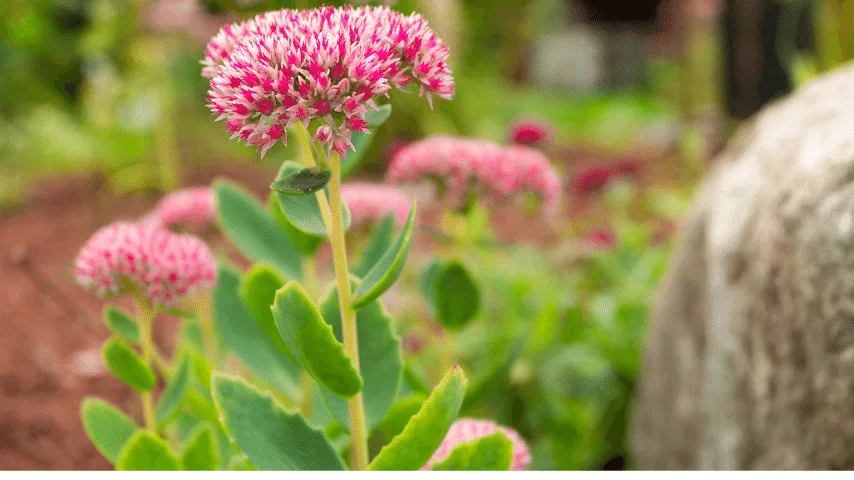
Autumn Joy Sedum (Hylotelephium herbstfreude) has excelled in drought tolerance, giving a bright look to your rock garden
This plant is best kept in soil that is either too sandy or extremely gravelly. It has excelled in drought tolerance.
Therefore, you do not need to worry about watering it on a strict schedule.
It produces flowers in clusters that are either light pink or red, giving your rock garden a bright look.
- Temperature: USDA hardiness zones for this plant are 8 to 9
- Plant Color: Produces purple, red, or pink flowers.
- Sun Exposure: Requires full sunlight.
- Soil Conditions; soil must be completely drained and either sandy or gravelly
- Plant Type: Autumn Joy Sedum is a hybrid plant created by cross-fertilizing a specie of sedum with that of an ice plant.
- Average height: Grows up to 2 feet tall.
19. Spiked Speedwell
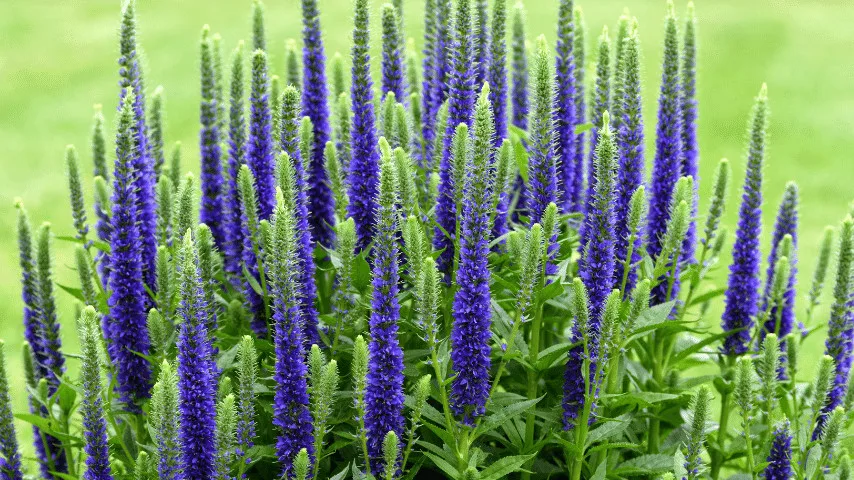
Spiked Speedwell (Veronica spicata ‘Royal Candles’) great plant for several areas such as rock gardens
Spiked Speedwell is a great plant for several areas such as rock gardens, flowering beds, bordering fences, and much more.
Often, this plant is used for creating a compact and decent porch line.
Moreover, this plant will do wonders for you if you have a proper drainage system and regularly provide it with abundant moisture.
Make sure that the soil does not begin to become too soggy; the root will start to rot this way.
- Temperature: USDA hardiness zones for this plant are 3 to 8.
- Plant Color: Produces blue and purple flowers.
- Sun Exposure: requires full sun
- Soil Conditions: Ensure that the soil is well-drained from excess moisture.
- Plant Type: Spiked Speedwell is a herbaceous perennial
- Average height: It reaches a height of 3 feet and spreads 2 feet wide.
20. Columbine
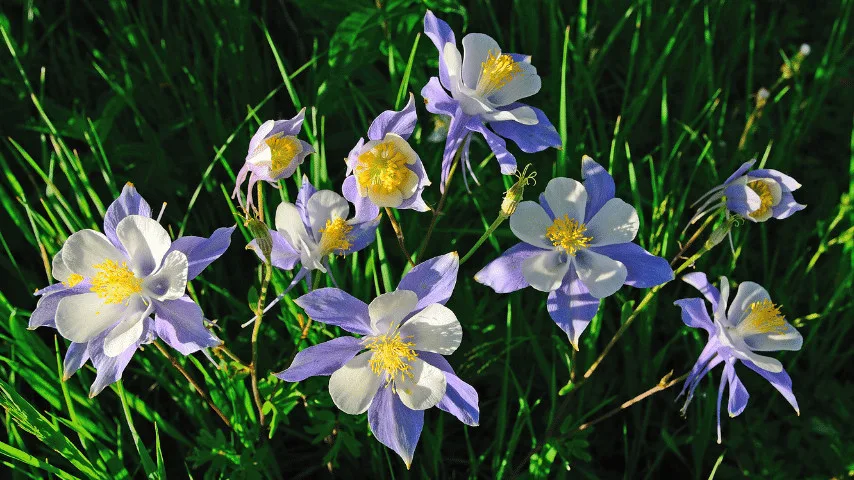
Columbine (Aquilegia spp.) are drought-tolerant, they are very suitable for rock gardens
Columbine is famous as it attracts hummingbirds. Because these plants are drought-tolerant, they are very suitable for rock gardens.
- Temperature: USDA hardiness zones for this plant are 3 to 9
- Plant Color: It produces flowers of a variety of colors, which include pink, purple, yellow, orange, and white.
- Sun Exposure: Requires full sun
- Soil Conditions: Make sure that the soil is well-drained.
- Plant Type: it is a perennial plant
21. Coneflower
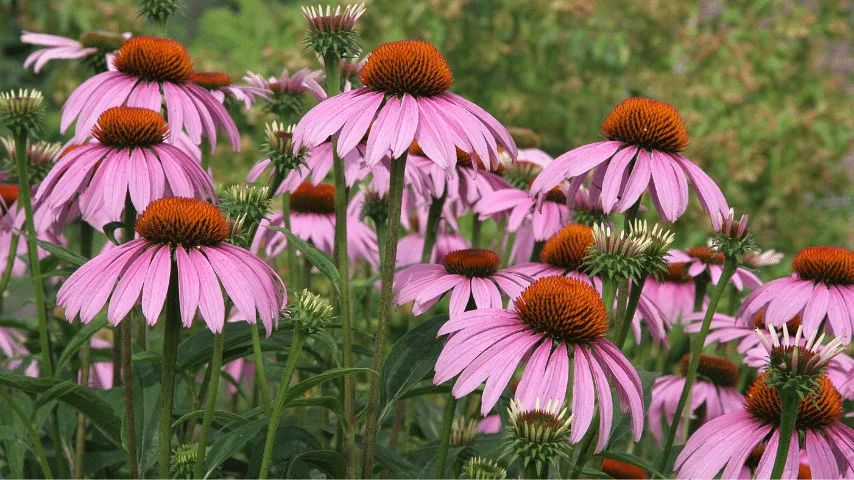
Coneflower (Echinacea spp.) is a hardy plant suitable for being grown in the rock garden
Coneflower is a hardy plant suitable for being grown in several soil conditions, including gravelly, loamy, or sandy soil.
- Temperature: USDA hardiness zones for this plant are 3 to 9
- Plant Color: It produces pink, purple, white, and red flowers.
- Sun Exposure: Requires full exposure to sunlight
- Soil Conditions: Soil must be completely drained and have medium moisture.
- Plant Type: It is a perennial plant
22. Purple Fountain Grass
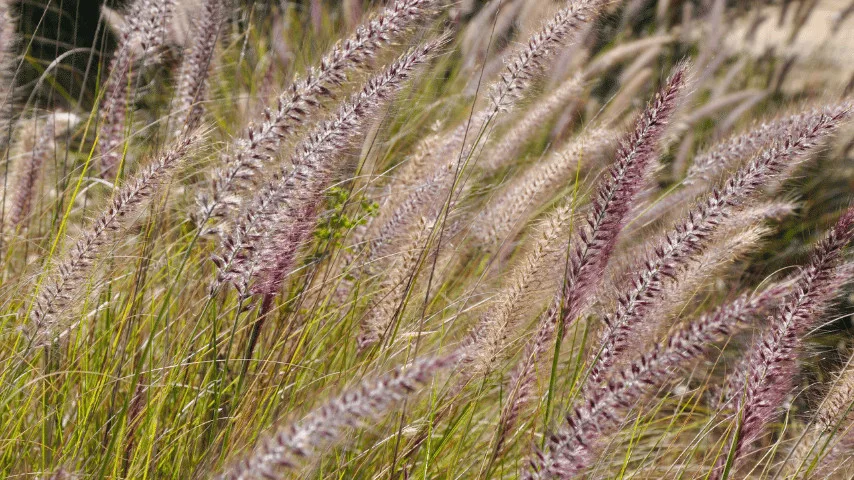
Purple Fountain Grass (Pennisetum setaceum ‘Rubrum’) grown with other plants in your rock garden
Purple Fountain Grass can be grown with other plants in a group setting and also as a stand-alone plant.
- Temperature: USDA hardiness zones for this plant are 9 to 10
- Plant Color: It produces purple tubular flowers
- Sun Exposure: Requires full sun; however, can also tolerate shade.
- Soil Conditions: well-drained soil
23. Blue Rug Juniper
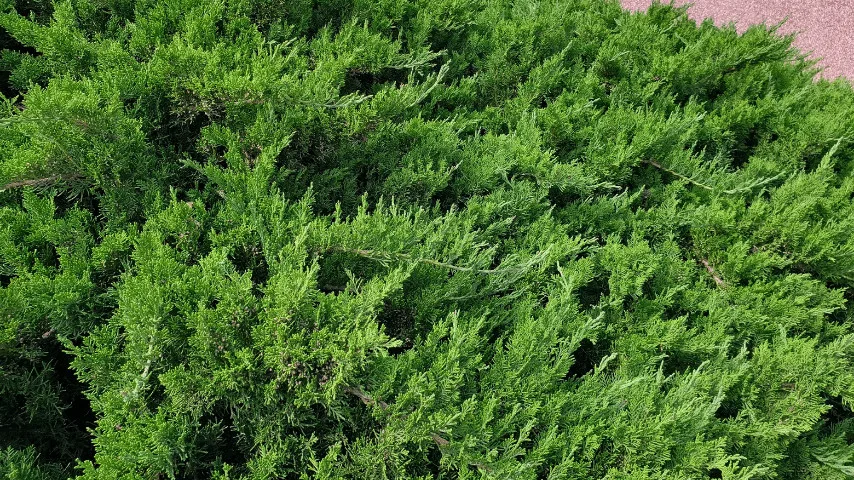
Blue Rug Juniper (Juniperus horizontalis ‘Wiltonii’) spreads like a mat in your rock garden
Blue Rug Juniper spreads like a mat and has thick blue and green foliage.
- Temperature: USDA hardiness zones for this plant are 3 to 9
- Plant Color: it is a non-flowering plant and has dense green foliage
- Sun Exposure: Full sun
- Soil Conditions: well-drained soil
24. Shasta Daisy
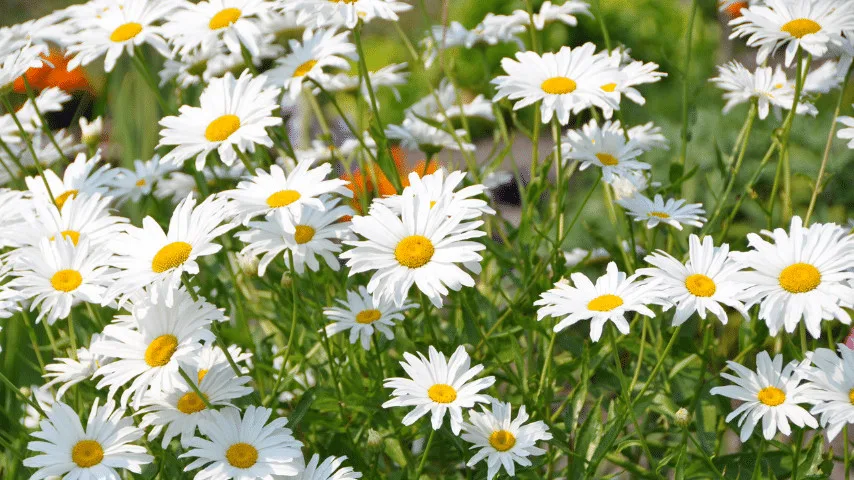
Shasta Daisy (Leucanthemum x superbum) is, the best choice for rock garden
Make sure that when caring for shasta daisy, you do not make the soil too wet, as the roots will start to rot.
- Temperature: USDA hardiness zones for this plant are 5 to 9
- Plant Color: White and yellow flowers
- Sun Exposure: Full sun
- Soil Conditions: Well-drained soil
25. Black-Eyed Susan
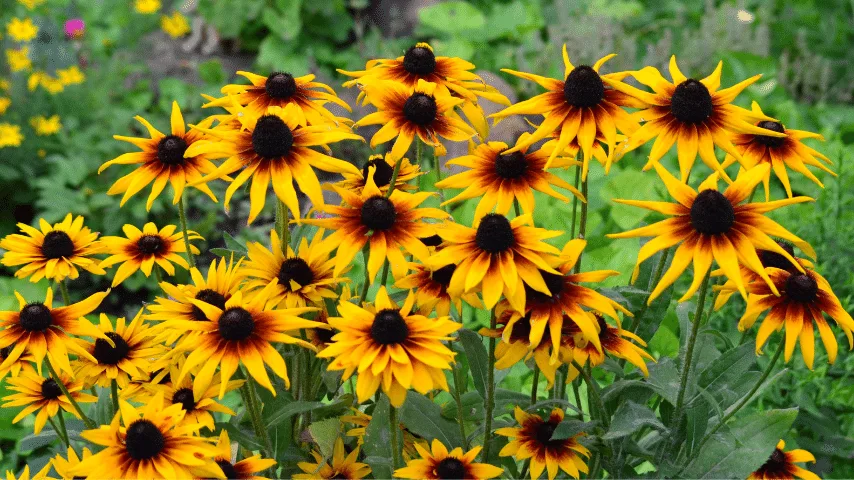
Black-Eyed Susan (Rudbeckia hirta), thrives well in your rock garden
The black-eyed Susan is a perennial plant and grows best in rich, fertile soil.
- Temperature: USDA hardiness zones for this plant are 3 to 7
- Plant Color: Bears yellow flowers
- Sun Exposure: Requires full sun
- Soil Conditions: well-drained soil
26. Perennial Salvia
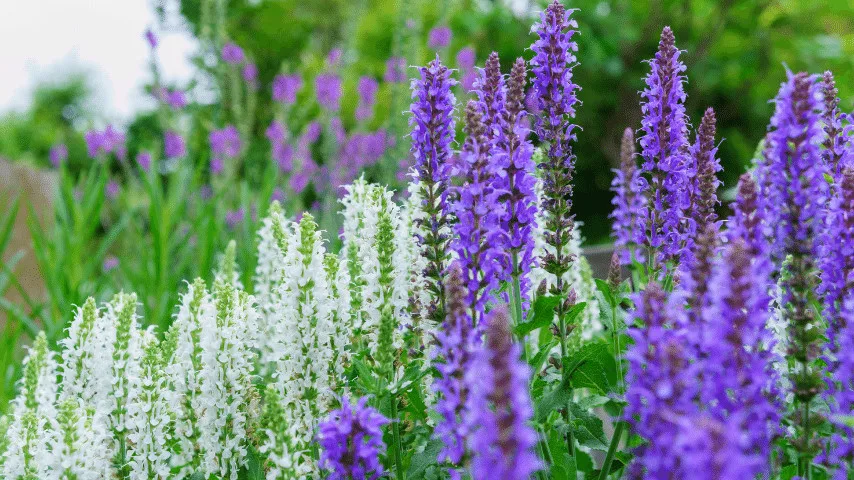
Perennial Salvia (Salvia spp.) place in the sunniest spot of your rock garden
Place perennial salvia in the sunniest spot of your rock garden, and it will do wonders for you.
- Temperature: USDA hardiness zones for this plant are 4 to 10
- Plant Color: Grows pink, purple, white, green, and blue flowers.
- Sun Exposure: Full sun
- Soil Conditions: well-drained soil
27. Six Hills Giant Catmint
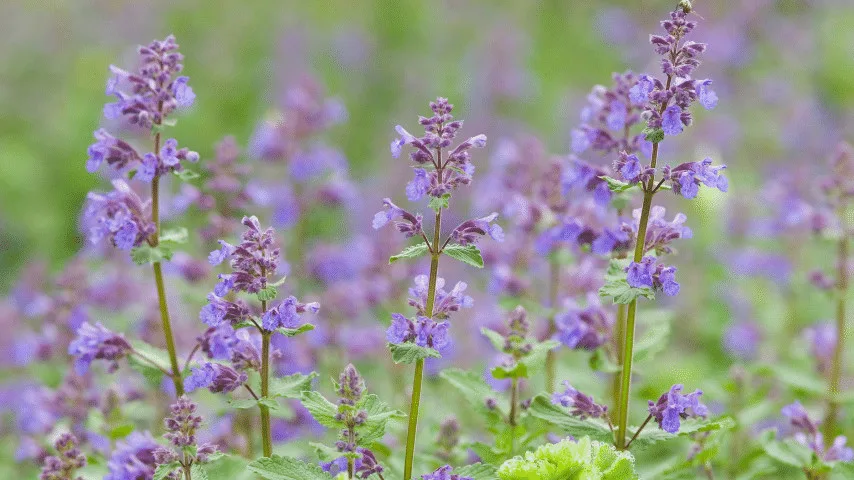
Six Hills Giant Catmint (Nepeta ‘Six Hills Giant’) can withstand dry conditions, it can be a perfect addition to your rock garden
Since this plant can withstand dry conditions, it can be a perfect addition to your rock garden.
- Temperature: USDA hardiness zones for this plant are 4 to 7
- Plant Color: Flower colors are white, purple, and blue.
- Sun Exposure: Full exposure to sunlight
- Soil Conditions: completely drained
28. Russian Sage
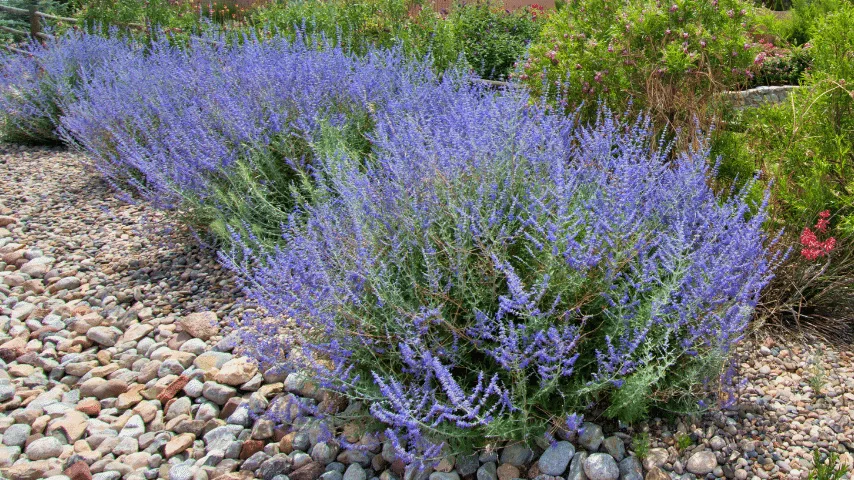
Russian Sage (Perovskia atriplicifolia) can give a beautiful appearance to your rock garden
With extremely thin and delicate flowers, Russian sage is one of those plants that can give a beautiful appearance to your rock garden.
- Temperature: USDA hardiness zones for this plant are 5 to 9
- Plant Color: Color of the flowers are blue and purple
- Sun Exposure: Full sun
- Soil Conditions: Well-drained.
29. Mugo Pine
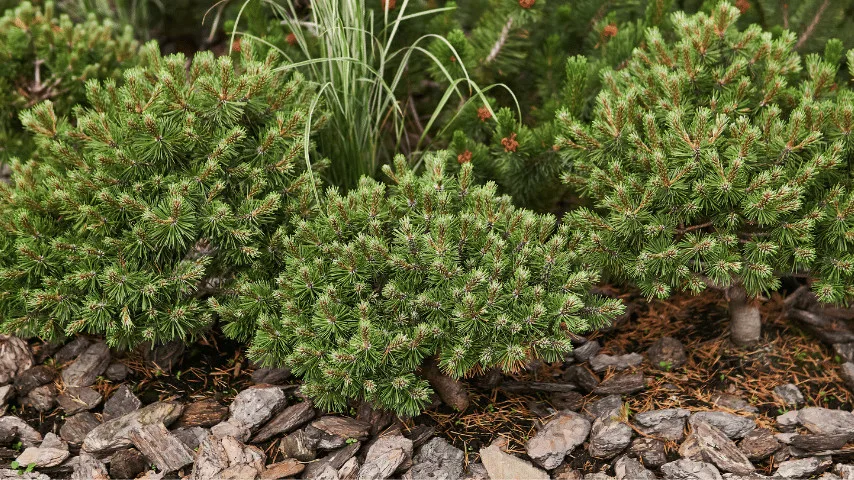
Mugo Pine (Pinus mugo) can be drought-tolerant, perfect for your rock garden
When caring for mugo pine, make sure that you water it every day in its initial development phase. Afterward, it becomes drought-tolerant.
- Temperature: USDA hardiness zones for this plant are 2 to 7
- Plant Color: This is a non-flowering plant
- Sun Exposure: full exposure to sunlight
- Soil Conditions: completely drained soil is required
30. Rock spray Cotoneaster
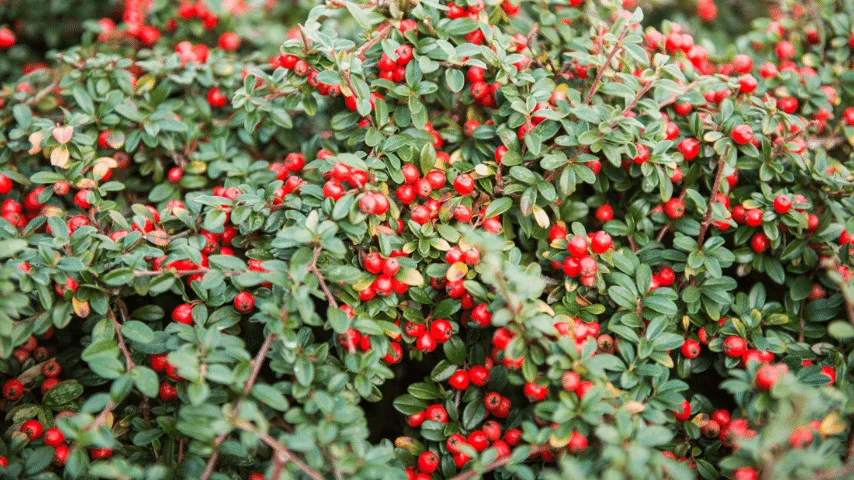
Rock spray Cotoneaster (Cotoneaster horizontalis) has excellent drought tolerance, perfect for your rock garden
This plant is commonly grown for its excellent drought tolerance and can tolerate poor soil conditions.
- Temperature: USDA hardiness zones for this plant are 5 to 7
- Plant Color: produces tiny pink flowers
- Sun Exposure: Can tolerate some shade
- Soil Conditions: moist and well-drained soil is a must
31. Lamb’s Ear
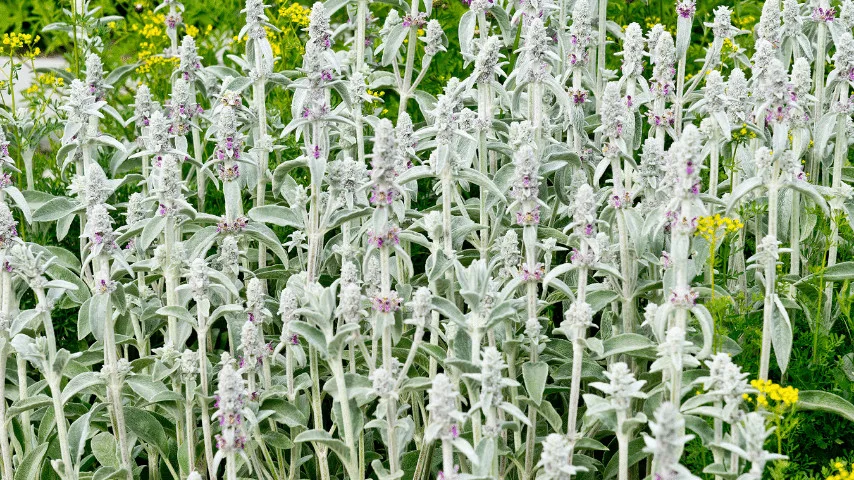
Lamb’s Ear (Stachys byzantina) velvety thick leaves thrive well in your rock garden
Lamb’s ears are so-called because of their natural, velvety thick leaves.
- Temperature: This plant is hardy in USDA zones 4 to 8
- Plant Color: Produces pink and purple flowers
- Sun Exposure: requires full sun
- Soil Conditions: soil should be well-drained
32. Maiden Grass
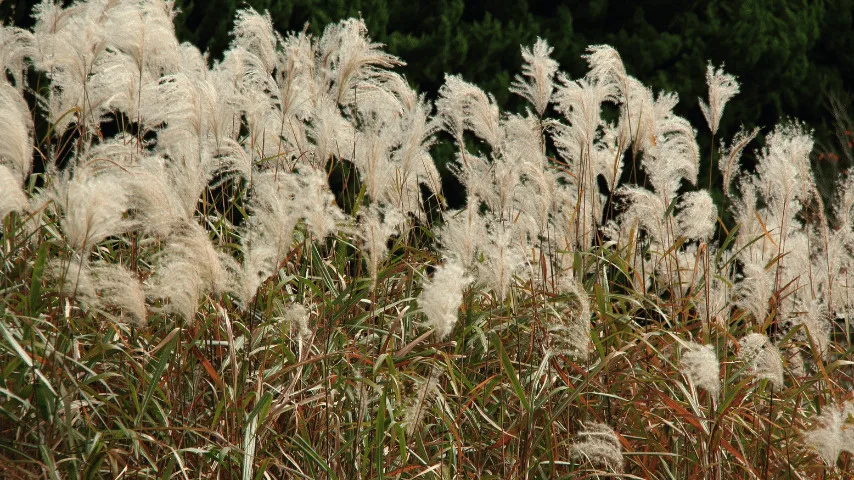
Maiden Grass (Miscanthus Sinensis ‘Gracillimus’) is extremely long grass and grows incredibly well in a rock garden
Maiden grass is the name of extremely long grass and grows incredibly well in a rock garden.
- Temperature: USDA hardiness zones for this plant are 5 to 9
- Plant Color: Produces copper and silver foliage
- Sun Exposure: Can tolerate some shade
- Soil Conditions: Soil must be well-drained
33. Rugosa Rose
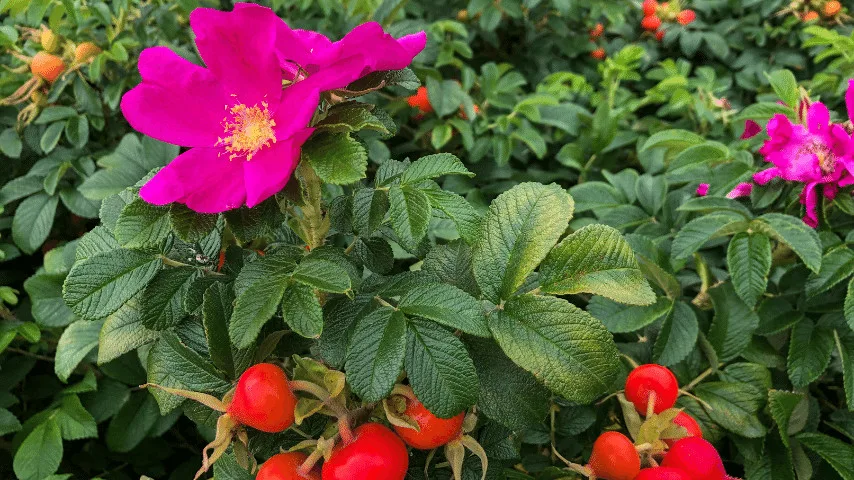
Rugosa Rose (Rosa rugosa), thrives in the rock garden with a good climate and enough water
To keep the flowers blooming for a long time, make sure you give them a good climate and enough water.
- Temperature: USDA hardiness zones for this plant are 2 to 7
- Plant Color: produces pink and white flowers
- Sun Exposure: full sun
- Soil Conditions: requires a slightly acidic soil
34. Rock Cress
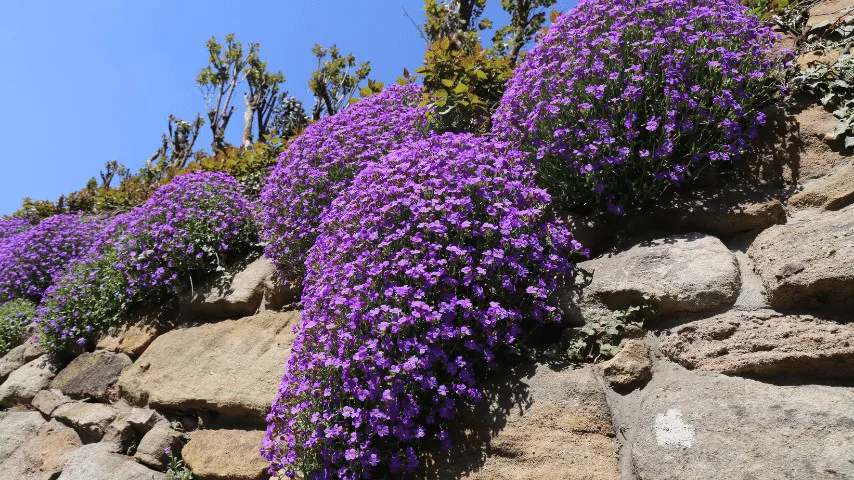
Rock Cress (Arabis) is a hardy plant, that will do wonders for the appearance of your rock garden.
Because Rockcress is a hardy plant, It’ll look fantastic in your rock garden.
This plant blooms in spring and produces large clusters of either pink and purple or pure white flowers.
Make sure that the soil has a proper drainage system, and this plant will do wonders for the appearance of your rock garden.
- Temperature: USDA hardiness zones for this plant are 3 to 8
- Plant Color: Produces yellow and purple small leaves.
- Sun Exposure: requires full sun but can also survive in partial shade
- Soil Conditions: Soil must be well-drained
- Plant Type: Rock Cress is an evergreen perennial plant
- Average height: It only grows up to 12 inches in height
35. Donkey Tails
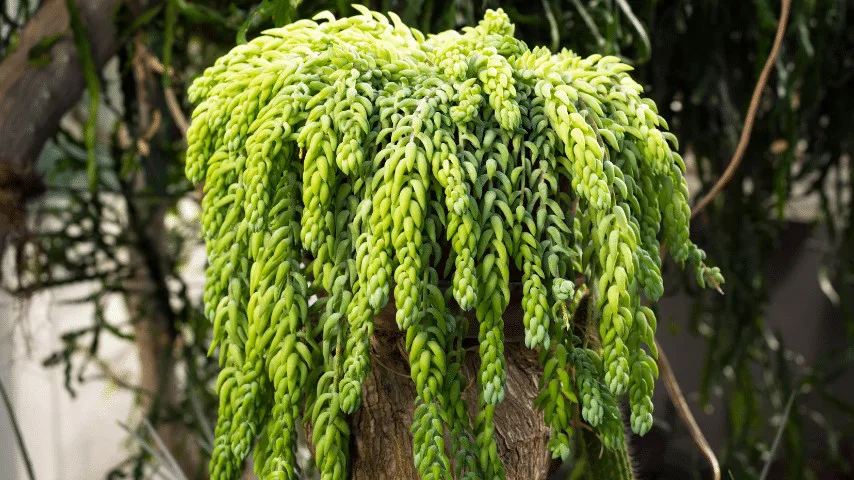
Donkey tails are yet another great plant for your rock garden as they are extremely low maintenance and drought-resistant
Donkey tails are yet another great plant for your rock garden as they are extremely low maintenance.
They are drought resistant and will do great, even in average soil.
- Temperature: USDA hardiness zones for this plant are 9 to 11
- Plant Color: These plants bear thick greyish leaves
- Sun Exposure: Can survive in full sun as well as part shade
- Soil Conditions: Well-drained soil
- Plant Type: It is a perennial plant
- Average height: Reaches about 4 feet in height
36. Spiderwort
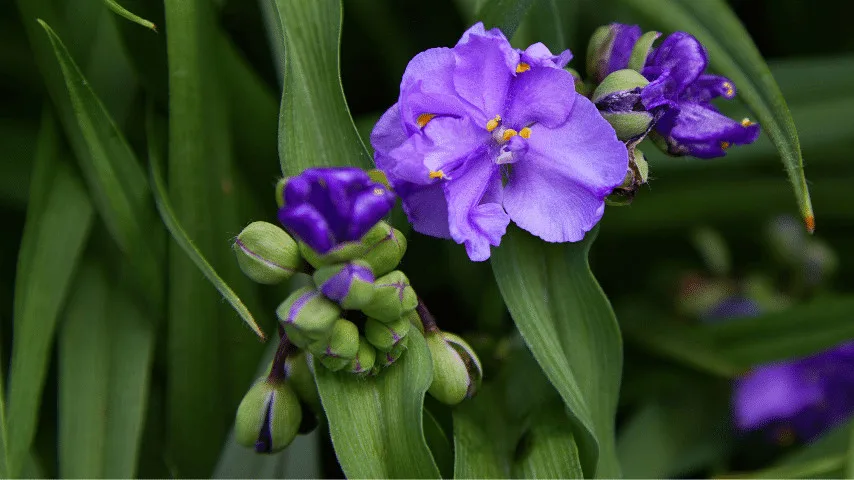
Spiderwort perfect addition to your rock garden with acidic soil and does well in exposure to partial sun
This plant has several other famous names, which include Wandering Jew and Indian Paint, owing to its red leaves.
It requires acidic soil and does well in exposure to partial sun.
- Temperature: This plant is hardy in USDA zones 4 to 9
- Plant Color: Bears red and green leaves, with flowers of multiple colors
- Sun Exposure: may survive in part shade
- Soil Conditions; soil should be well-drained and medium-moistured
- Average height: Grows up to 1 to 3 feet tall.
37. Thrift
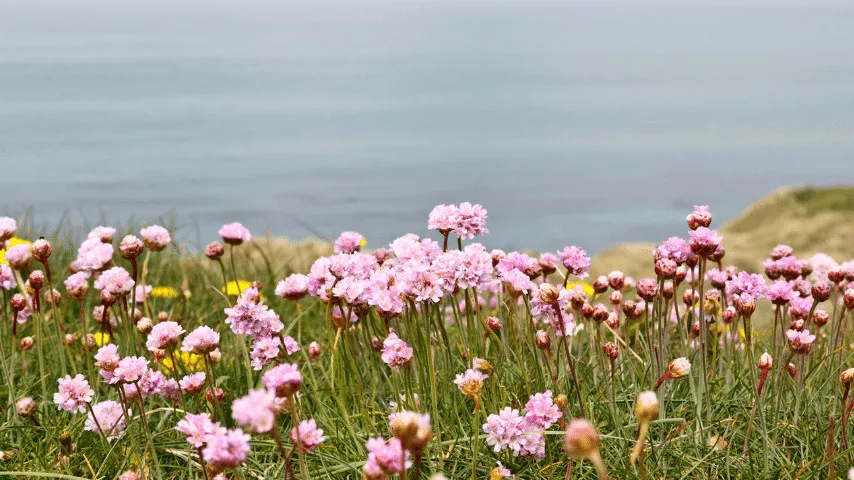
Thrift (Armeria Maritima) will do well for you in a rock garden and usually does not require any deadheading
This plant is also known as sea pink and belongs to Great Britain.
Because it is a very condensed plant, it will do well for you in a rock garden and usually does not require any deadheading.
Make sure that this plant has a proper drainage system. In the case of water-logged soil, the roots will start to rot.
- Temperature: USDA hardiness zones for this plant are 6 to 9
- Plant Color: It produces green foliage and pink flowers
- Sun Exposure: Requires full sun but can also tolerate partial shade.
- Soil Conditions: Soil should be well-drained
- Plant Type: Armeria Maritima is an evergreen perennial
- Average height: It grows only to a small height of 1 foot.
38. Tickseed
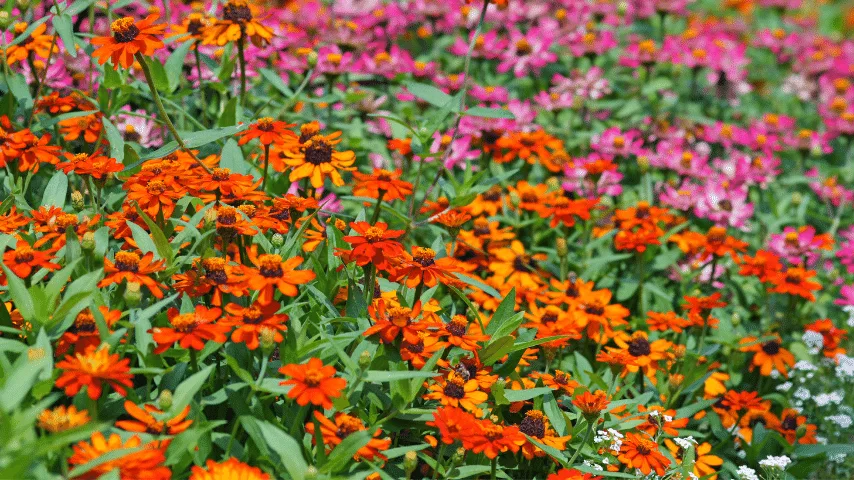
Tickseed (Coreopsis) is a plant in your rock garden that blooms for the entire summer season
If you want to have a plant in your rock garden that blooms for the entire summer season, then tickseed it is.
It blooms for an exceptionally long period of about four to five months and produces large and showy flowers.
These flowers are white, with a slight tinge of purple here and there.
This plant requires very little maintenance that can tolerate almost any kind of soil, drought, and humid weather.
Moreover, a bonus is also that it is highly resistant to animals and insects.
- Temperature: This plant is hardy in USDA zones 4 to 9
- Plant Color: Produces white flowers with purple edges
- Sun Exposure: can survive in partial shade
- Soil Condition: medium moisture soil
- Plant Type: It is a perennial plant
- Average height: it grows to an exceptional height of 6 to 9 feet
39. Irish Moss
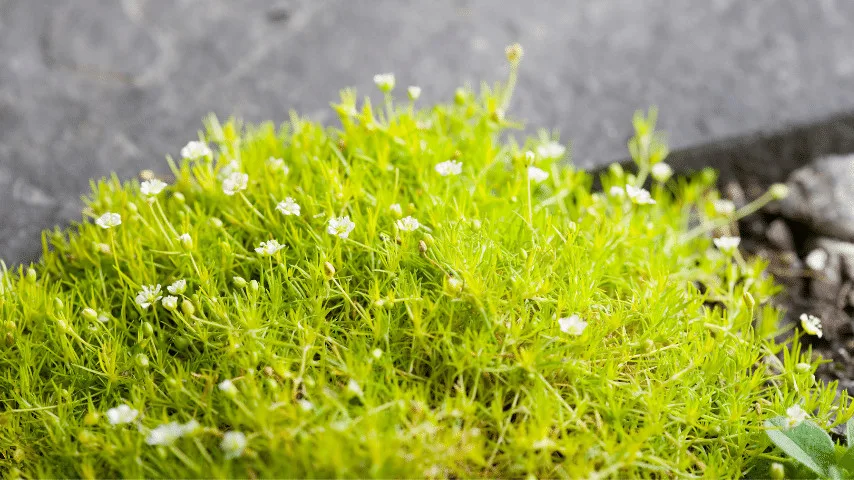
Irish Moss (Sagina Sabulata) looks more like a green mat giving a natural look in your rock garden
Once grown in your rock garden, Irish Moss looks more like a green mat giving a natural look to your space.
It is not only lively but also cathartic to have this mat-like plant in your garden. Its touch is extremely soft, and you would love to take a nap on it.
- Temperature: This plant is hardy in USDA zones 4 to 8
- Plant Color: Produces dense foliage that spreads like a mat
- Sun Exposure: requires full sun
- Soil Conditions: Should be well-drained
- Average height: it grows about 3 to 6 inches wide.
40. Nasturtium
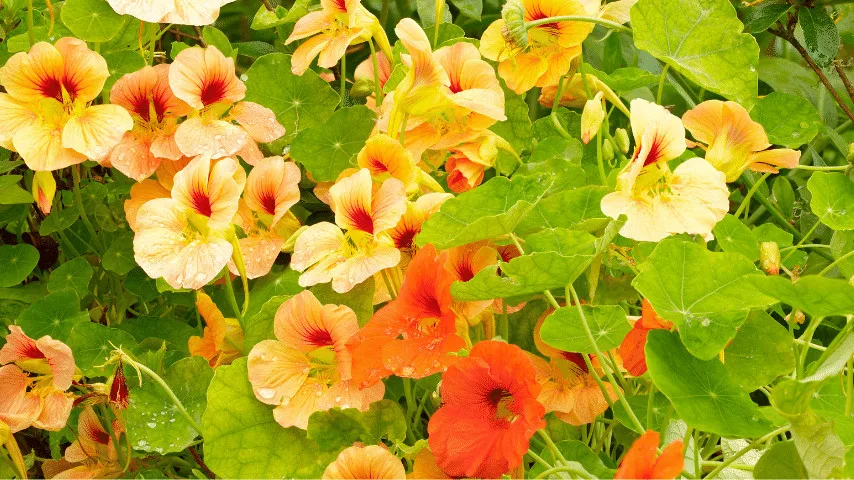
Nasturtium is the best choice for your rock gardens since it requires low maintenance
Nasturtium is an annual plant that is one of the best choices for your rock gardens. It requires low maintenance,
which means that you do not have to water it frequently or ensure the fertility of the soil.
- Temperature: This plant is hardy in USDA zones 4 to 8
- Sun Exposure: Requires full exposure to sunlight to part shade
- Soil Conditions: Soil may or may not be fertile
- Plant Type: Nasturtium is an annual plant
- Average height: Reaches a height of 1 to 3
41. Prickly Pear Cactus
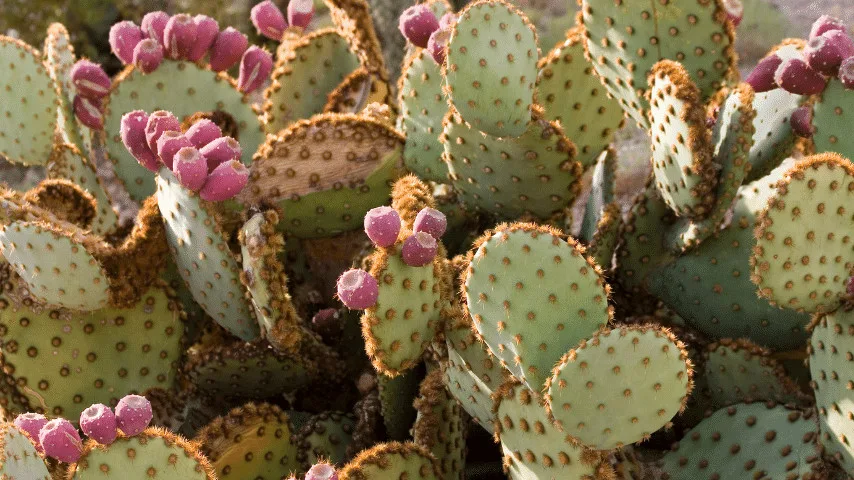
Prickly Pear Cactus planting them in your rock garden can bring some variety to your personal space
Since cactus plants are usually known for their spiky and succulent nature, planting them in your rock garden can bring some variety to your personal space.
This plant can tolerate extreme temperatures and does not require much maintenance to be kept alive.
- Temperature: USDA hardiness zones for this plant are 2 to 9.
- Plant Color: Green spiky leaves with thorns and pink heads.
- Sun Exposure: Requires full sun.
- Soil Conditions: Should be loamy and well-drained.
- Plant Type: Prickly pear cactuses are slow-growing perennials.
- Average height: Height does not increase after reaching 12 to 15 inches.
42. Geranium Shepherds Warning
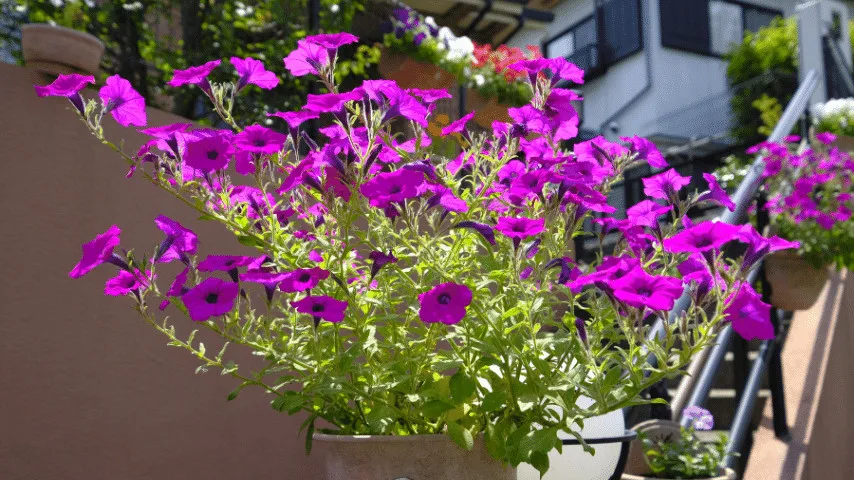
Geranium Shepherds Warning (Geranium sanguineum) are very low-maintenance, perfect to be planted in a rock garden
Blooming in spring till late summer, geraniums are known for their quick and easy methods of the plantation.
They are very low-maintenance and can conveniently be grown through seeds.
They look at their best when surrounded by plants and flowers of varying colors, which makes them perfect to be planted in a rock garden.
- Temperature: This plant is hardy in USDA zones 4 to 8
- Plant Color: This plant produces pink flowers
- Sun Exposure: requires full to partial sunlight
- Soil Conditions: Clay should be used for potting
- Plant Type: Geranium sanguineum is a perennial plant
- Average height: Reaches up to five to nine inches in height only
43. Ajuga Black Scallop
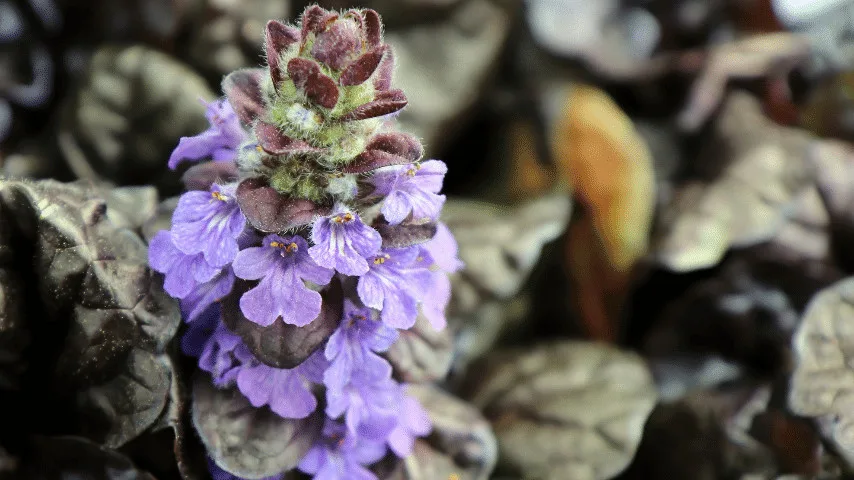
Ajuga Black Scallop (Ajuga Reptans Binblasca) effective ground cover, grow it in your rock garden in a compact spot
Ajuga Black Scallop is best known for its aromatic dark blue flowers that have a soft velvety texture.
This plant is very well known for effective ground cover, so if you are planning to grow it in your rock garden, make sure that you plant it in a compact spot.
It requires dry soil for optimal growth and can also be planted in icy regions.
However, when you grow it in colder temperatures, ensure that you protect the roots with a generous layer of mulch.
- Temperature: This plant is hardy in USDA zones 4 to 9
- Plant Color: it produces blue flowers with a distinct aroma
- Sun Exposure: requires full to partial sun
- Soil Conditions: This plant needs a well-drained soil
- Plant Type: it is an evergreen perennial plant
- Average height: it has a very short height of 3 to 6 inches
44. Basket of Gold
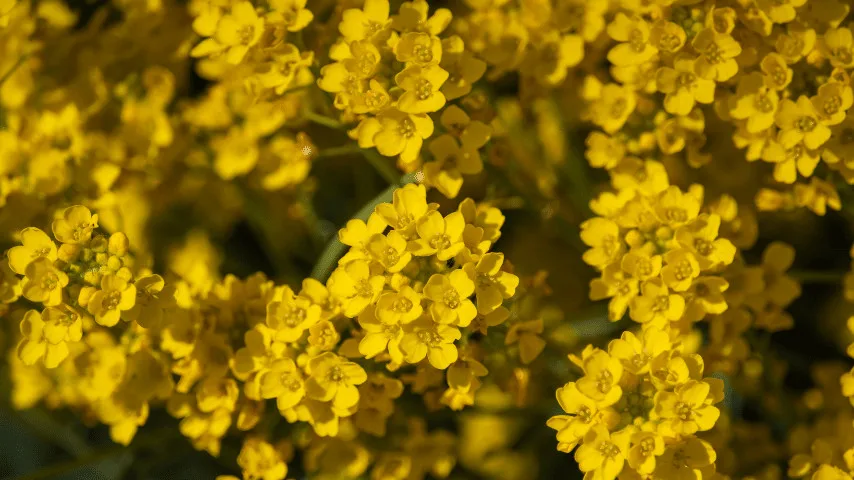
Basket of Gold (Aurinia Saxatilis) is resistant to humidity and is best for rock gardens with fertile soil
Belonging to the southern and central regions of Europe, Aurinia saxatilis is a perennial plant. This plant must be potted in fertile soil,
as it cannot tolerate clay. Moreover, it is also resistant to humidity. Basket of Gold is so-called due to its tiny clusters of gold-colored flowers.
They bloom from April to May and thrive in full sunlight.
- Temperature: USDA hardiness zones for this plant are 3 to 8
- Plant Color: Produces small gold-colored flowers in clusters.
- Sun Exposure: thrives in full sun
- Soil Conditions: Soil should be well-drained and fertile.
- Plant Type: it is an annual plant.
- Average height: Reaches a short height of about 6 to 12 inches
45. Crested iris
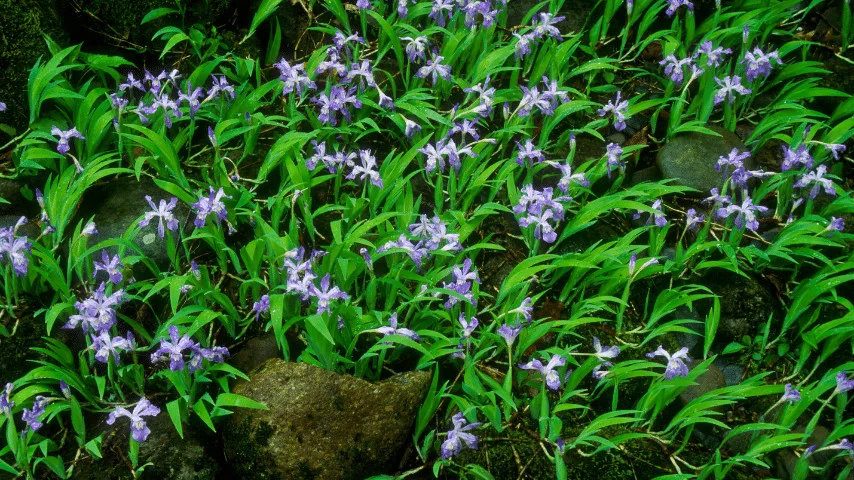
Crested iris (Iris Cristata) attracts snails and slugs could be a big problem especially if your entire rock garden becomes infected
Iris Cristata belongs to the eastern regions of the US and produces blue, purple, or lilac flowers.
The caution about this flower is that while it attracts butterflies and insects for pollination, it also attracts snails and slugs.
This might be a major issue, especially if your entire rock garden becomes infected. As a result, keeping an eye on this plant is typically advised.
- Temperature: USDA hardiness zones for this plant are 4 to 7
- Plant Color: Produces lilac, blue, or purple flowers.
- Sun Exposure: requires full sun
- Soil Conditions: Should be well-drained and with an acidic pH
- Plant Type: It is a perennial plant
- Average height: Reaches a height of 4 to 16 inches.
46. Snow Flurry Aster
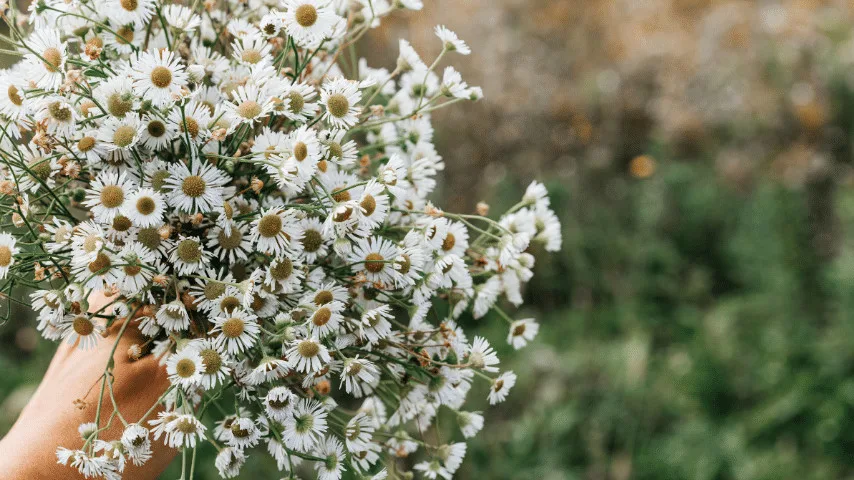
Snow Flurry Aster (Symphyotrichum ericoides) delicate plant yet drought tolerant, perfect for your rock garden
Although snow flurry aster is considered a very delicate plant because of its small white flowers.
It is tolerant to many things, such as drought, poor soil conditions, humidity, erosion, and infections.
- Temperature: USDA hardiness zones for this plant are 4 to 7
- Plant Color: Produces delicate white flowers
- Sun Exposure: Requires full to partial sunlight.
- Soil Conditions: tolerant to all kinds of soil, be it loamy, clay, or sand.
- Plant Type: it is a perennial plant
- Average height: Only grows about 6 inches in height
47. Hardy Plumbago
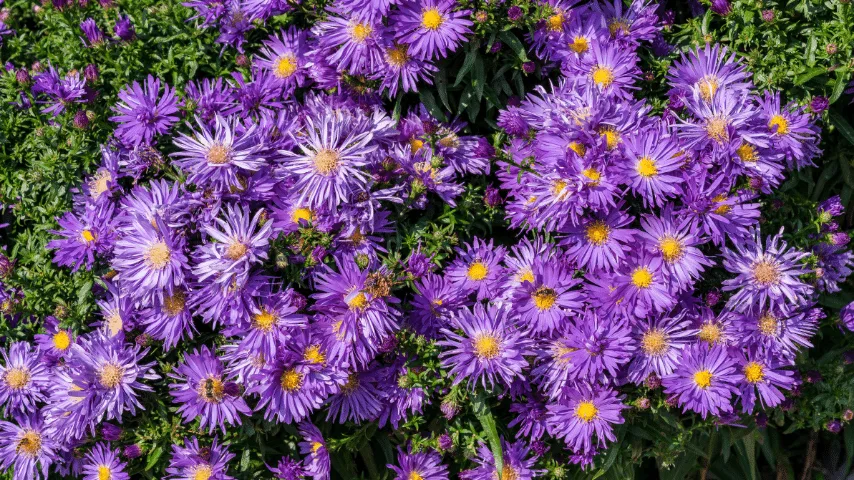
Hardy Plumbago (Ceratostigma plumbaginoides) is a great choice for your rock gardens in a compact space
Belonging to the western regions of China, hardy plumbago is a great choice for your rock gardens, primarily because of its deep blue flowers.
It’s one of those plants that like shade instead of sunlight.
When planting hardy plumbago, make sure that you plant it in a compact space as it is very likely to spread rapidly over the available land.
- Temperature: This plant is hardy in USDA zones 3 to 9.
- Plant Color: It is famous for its bright blue flowers
- Sun Exposure: Requires partial shade.
- Soil Conditions: Should be well-drained
- Plant Type: It is a perennial plant belonging to western china
- Average height: Grows only 6 to 10 inches in height
48. Missouri Evening Primrose
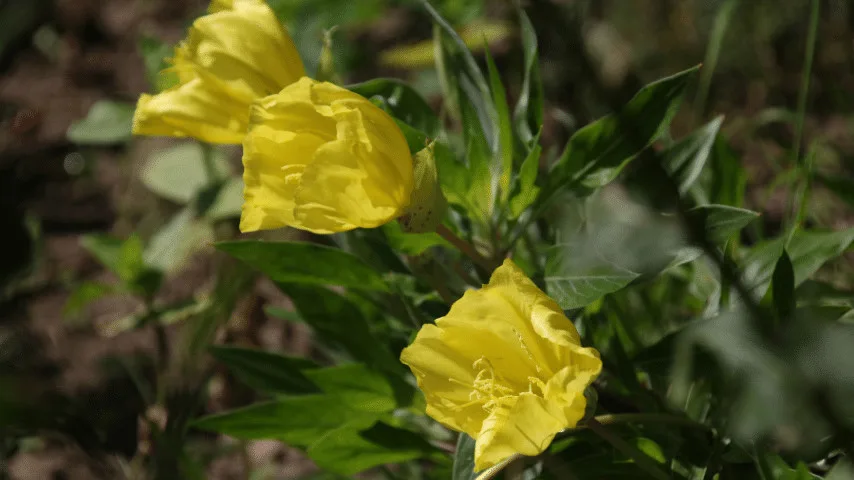
Missouri Evening Primrose (Oenothera missouirensis) has excellent tolerance to drought, a great addition to your rock garden
Belonging to the Midwest region of the country,
Missouri evening primroses bloom from May to August and show excellent tolerance to drought and poor soil conditions.
- Temperature: This plant is hardy in USDA zones 4 to 8
- Plant Color: Produces large light yellow flowers
- Sun Exposure: requires full to partial sun
- Soil Conditions: Should be well-drained of excess moisture
- Plant Type: it is a perennial plant
- Average height: This plant only grows six to eight inches.
49. Blue Zinger Sedge
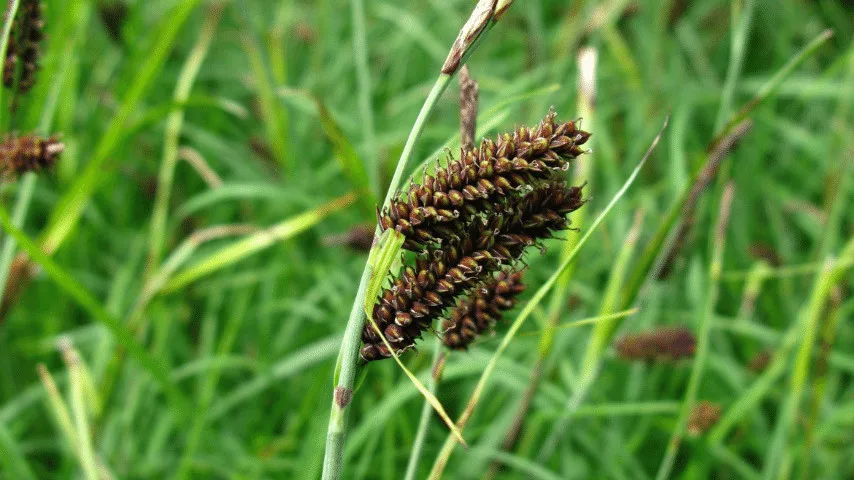
Blue Zinger Sedge (Carex Flacco) shows great resistance to drought and infections, perfect for your rock garden with partial shade
Blue Zinger Sedge is known for its extremely thin foliage that grows all year round and shows great resistance to infections and drought.
It can be grown in partial exposure to the sunshade.
- Temperature: This plant is hardy in USDA zones 4 to 9
- Plant Color: it produces thin green foliage
- Sun Exposure: Requires full sun
- Soil Conditions: Should be well-drained
- Plant Type: It is an evergreen perennial
- Average height: Reaches a maximum height of 8 to 12 inches
50. Cushion Spurge
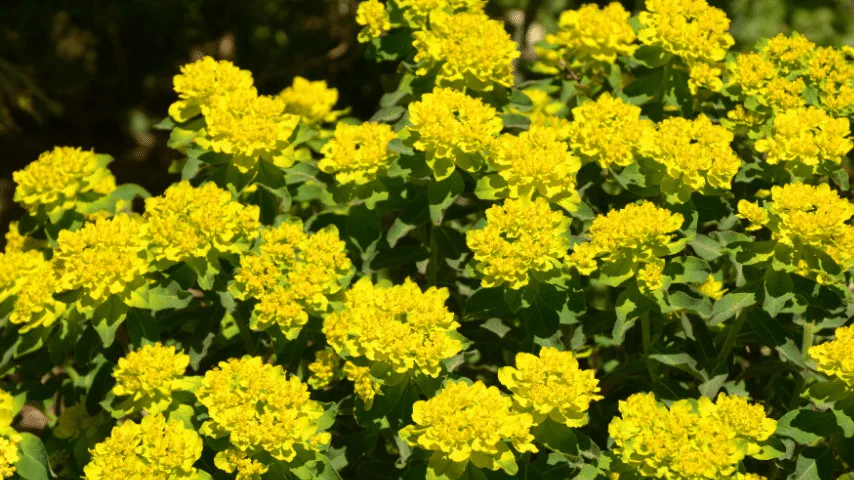
Cushion Spurge (Euphorbia Polychorma)attracts a lot of insects for pollination, a great addition to your collection of rock garden plants
Cushion spurge is so-called due to its cushion-like flowers, making it a great addition to your collection of rock garden plants.
It also attracts a lot of insects for pollination.
- Temperature: USDA hardiness zones for this plant are 6 to 10.
- Plant Color: Produces small yellow flowers
- Sun Exposure: can survive in partial shade
- Soil Conditions: tolerant to many kinds of soil, be it loamy, sandy, or gravelly.
- Plant Type: it is a perennial plant
- Average height: grows 12 to 18 inches in height
Conclusion On Best Plants for Rock Gardens
Rockeries and alpine gardens are other names for rock gardens. The concept of rock gardens originated in China and Japan, where numerous experiments were carried out to grow plants in hilly areas.
Since then, rock gardens have been brought into implementation not only in these two countries but also to pay tribute to the mountainous regions of many other countries
Rock gardens allow you to grow many beautiful plants in a concentrated space. If you want to make a rock garden, you can plant any of the plants mentioned above to maximize the ambiance of your space.
I hope you enjoyed our selection of the best plants for rock gardens.


